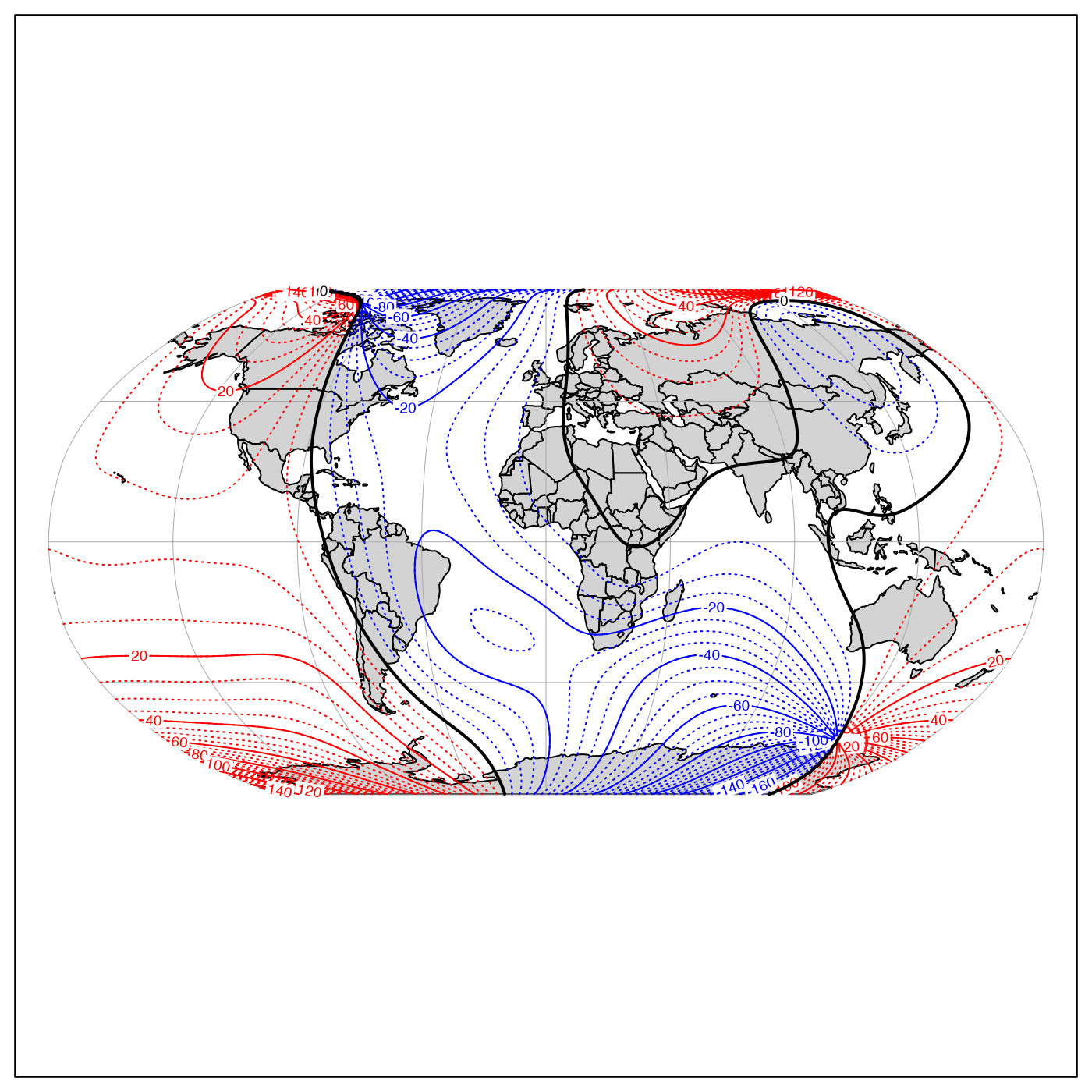Implements the 12th, 13th and 14th generations of the International Geomagnetic Reference Field (IGRF), based on a reworked version of a Fortran code downloaded from a NOAA website (see “References”).
Arguments
- longitude
longitude in degrees east (negative for degrees west), as a number, a vector, or a matrix.
- latitude
latitude in degrees north, as a number, vector, or matrix. The shape (length or dimensions) must conform to the dimensions of
longitude.- time
The time at which the field is desired. This may be a single value or a vector or matrix that is structured to match
longitudeandlatitude. The value may a decimal year, a POSIXt time, or a Date time.- version
an integer that must be 12, 13 or 14, to specify the version number of the formulae. Note that 13 became the default on 2020 March 3 and that 14 became the default on 2025 January 7.
Details
The Fortran code (subroutines igrf12syn, igrf13syn and igrf14syn) seem
to have been written by Susan Macmillan of the British Geological Survey.
Comments in the source code igrf14syn (the current default used here)
indicate that its coefficients were agreed to in November 2024 by the IAGA
Working Group V-MOD. Other comments in that code suggest that the proposed
application time interval is from years 1900 to 2030, inclusive, but that
only dates from 1945 to 2020 are to be considered definitive.
References
The underlying Fortran code for version 12 is from
igrf12.f, downloaded the NOAA websitehttps://www.ngdc.noaa.gov/IAGA/vmod/igrf.htmlon June 7, 2015. For version 13,igrf13.fwas downloaded from the NOAA websitehttps://www.ngdc.noaa.gov/IAGA/vmod/igrf.htmlon March 3, 2020. For version 14,igrf14.fwas downloaded from the NOAA websitehttps://www.ngdc.noaa.gov/IAGA/vmod/igrf14.fon January 7, 2025.Witze, Alexandra. “Earth's Magnetic Field Is Acting up and Geologists Don't Know Why.” Nature 565 (January 9, 2019): 143. doi:10.1038/d41586-019-00007-1
Alken, P., E. Thébault, C. D. Beggan, H. Amit, J. Aubert, J. Baerenzung, T. N. Bondar, et al. "International Geomagnetic Reference Field: The Thirteenth Generation." Earth, Planets and Space 73, no. 1 (December 2021): 49. doi:10.1186/s40623-020-01288-x .
Chulliat, Arnaud, Manoj nair, Li-Yin Young, et al. The US/UK World Magnetic Model for 2025-2030. NOAA National Centers for Environmental Information, 2025. doi:10.25923/PRBC-S316 .
See also
Other things related to magnetism:
applyMagneticDeclination(),
applyMagneticDeclination,adp-method,
applyMagneticDeclination,adv-method,
applyMagneticDeclination,cm-method,
applyMagneticDeclination,oce-method
Author
Dan Kelley wrote the R code and a fortran wrapper to the igrf1X.f
subroutine (where X can be 12, 13 or 14), which was written by Susan
Macmillan of the British Geological Survey and distributed “without
limitation” (email from SM to DK dated June 5, 2015). This version was
updated subsequent to that date; see “Historical Notes”.
Examples
library(oce)
# 1. Today's value at Halifax NS
magneticField(-(63 + 36 / 60), 44 + 39 / 60, Sys.Date())
#> $declination
#> [1] -16.23289
#>
#> $inclination
#> [1] 66.33456
#>
#> $intensity
#> [1] 51076.96
#>
# 2. World map of declination in year 2025.
# \donttest{
data(coastlineWorld)
par(mar = rep(0.5, 4)) # no axes on whole-world projection
mapPlot(coastlineWorld, projection = "+proj=robin", col = "lightgray")
# Construct matrix holding declination
lon <- seq(-180, 180)
lat <- seq(-90, 90)
dec2025 <- function(lon, lat) {
magneticField(lon, lat, 2025)$declination
}
dec <- outer(lon, lat, dec2025) # hint: outer() is very handy!
# Contour, unlabelled for small increments, labeled for
# larger increments.
mapContour(lon, lat, dec,
col = "blue", levels = seq(-180, -5, 5),
lty = 3, drawlabels = FALSE
)
mapContour(lon, lat, dec, col = "blue", levels = seq(-180, -20, 20))
mapContour(lon, lat, dec,
col = "red", levels = seq(5, 180, 5),
lty = 3, drawlabels = FALSE
)
mapContour(lon, lat, dec, col = "red", levels = seq(20, 180, 20))
mapContour(lon, lat, dec, levels = 180, col = "black", lwd = 2, drawlabels = FALSE)
mapContour(lon, lat, dec, levels = 0, col = "black", lwd = 2)
 # }
# 3. Declination differences between versions 13 and 14
lon <- seq(-180, 180)
lat <- seq(-90, 90)
decDiff <- function(lon, lat) {
old <- magneticField(lon, lat, 2025, version = 13)$declination
new <- magneticField(lon, lat, 2025, version = 14)$declination
new - old
}
decDiff <- outer(lon, lat, decDiff)
t.test(decDiff)
#>
#> One Sample t-test
#>
#> data: decDiff
#> t = -3.0533, df = 65340, p-value = 0.002264
#> alternative hypothesis: true mean is not equal to 0
#> 95 percent confidence interval:
#> -0.038733905 -0.008446985
#> sample estimates:
#> mean of x
#> -0.02359044
#>
# }
# 3. Declination differences between versions 13 and 14
lon <- seq(-180, 180)
lat <- seq(-90, 90)
decDiff <- function(lon, lat) {
old <- magneticField(lon, lat, 2025, version = 13)$declination
new <- magneticField(lon, lat, 2025, version = 14)$declination
new - old
}
decDiff <- outer(lon, lat, decDiff)
t.test(decDiff)
#>
#> One Sample t-test
#>
#> data: decDiff
#> t = -3.0533, df = 65340, p-value = 0.002264
#> alternative hypothesis: true mean is not equal to 0
#> 95 percent confidence interval:
#> -0.038733905 -0.008446985
#> sample estimates:
#> mean of x
#> -0.02359044
#>